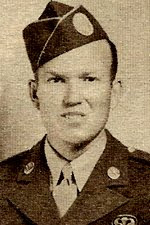Glen Hubbard Stevens was the fourth of 18 or 19 men scheduled to parachute from the C47 troop transport plane with tail No. 43-15312 during Operation Neptune on June 6, 1944.
He did not appear nervous. In fact, he slept most of the two-hour flight from England. He was probably wearing an identification bracelet and carrying an Army-issued fountain pen.
The paratroopers were not able to jump at the location they had hoped – too much enemy fire. So they jumped as close to their target as they could.
We know these things about the last minutes of Stevens’ life because the Army kept records and because at least one of the men on the plane survived the invasion of Normandy.
James E. Humphrey, whose T/4 rank was the same as Stevens, was scheduled to be the 17th of 18 jumpers that day, military records show.
He said he was the 19th and last jumper, according to a letter Stevens’ fiancée wrote Stevens’ parents on Jan. 5, 1945.
Humphrey, according to the letter, contacted Viva Nevil at the bank where she worked in Dallas. He identified himself as “a friend of Steve’s” and asked if he could make an appointment to meet with her.
“I could hardly wait to hear what he had to tell me about Glen,” Nevil wrote in her letter.
They met that same night, a Tuesday, Jan. 2, 1945.
Humphrey told Nevil they learned of plans for the invasion 12 days before D-Day, which was June 6. He told her he was “one of the few” from their plane who survived the attack. Nevil noted in her letter that Humphrey was also in another major battle and that his medals included a purple heart and a silver star.
She wrote that he had a “terrible leg,” having been hit by machine-gun fire and that he was on his way to the hospital at Fort Sam Houston, where he expected it would take about three months “to fix his leg up.”
Humphrey said he never saw Glen Hubbard again after he jumped from the plane. “Humphrey said he didn’t know how he was killed but he did know it was quick,” Nevil wrote.
Nevil wrote Glen Hubbard’s parents that Humphrey told her he would try to return to Dallas at some point and that she would insist on him traveling to their home in Leonard, Texas, if he did.
She had asked if there were anything special Humphrey might want to tell John David and Ethel Stevens about their son. He responded: “Nothing, only this – Glen was doing what he wanted to do.”


